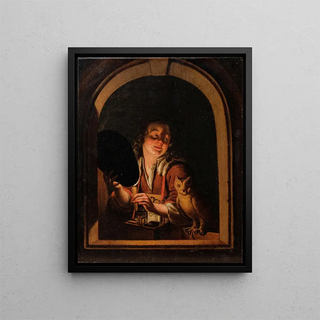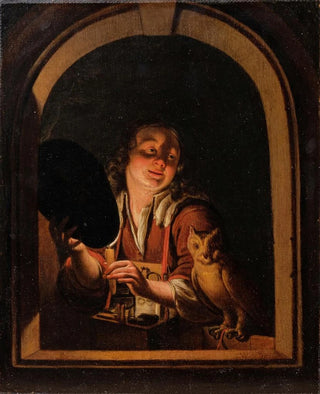Art print | A young boy with an owl - Willem van Mieris


View from behind

Frame (optional)
The art print "A Young Boy with an Owl" by Willem van Mieris captivates with its charm and elegance, immersing the viewer in a universe where nature and humanity meet with rare delicacy. This painting, depicting a young boy holding an owl, evokes an atmosphere filled with tenderness and innocence, while revealing the subtleties of attentive observation of daily life in the 17th century. The artist, a master of detail, manages to capture not only the physical appearance of his subject but also a certain essence of childhood, full of curiosity and wonder. Every brushstroke seems to tell a story, inviting the viewer to reflect on the relationship between the child and the bird, a symbol of wisdom and mystery.
Style and uniqueness of the art print
Willem van Mieris's style is distinguished by its finesse and attention to detail, characteristic of the Dutch Baroque movement. In "A Young Boy with an Owl," the carefully chosen color palette, ranging from soft tones to more vivid shades, creates a visual harmony that draws the eye. Textures are rendered with remarkable precision, whether it is the owl's feathers or the young boy's clothing, thus revealing the artist's technical virtuosity. The use of light and shadow adds an almost sculptural dimension to the composition, bringing the characters and their environment to life. This art print does not merely depict a static scene; it suggests a narrative, an interaction between man and nature, where each element carries meaning.
The artist and his influence
Willem van Mieris, a Dutch painter of the 17th century, is often recognized for his skill in capturing the nuances of daily life through portraits and genre scenes. Son of the artist Frans van Mieris, he inherited a rich artistic legacy that shaped his approach. Although less well-known than some of his contemporaries, Van Mieris managed to forge a distinctive identity, marked by an intimate style and meticulous attention to detail. His influence extends beyond his era, inspiring

Matte finish

View from behind

Frame (optional)
The art print "A Young Boy with an Owl" by Willem van Mieris captivates with its charm and elegance, immersing the viewer in a universe where nature and humanity meet with rare delicacy. This painting, depicting a young boy holding an owl, evokes an atmosphere filled with tenderness and innocence, while revealing the subtleties of attentive observation of daily life in the 17th century. The artist, a master of detail, manages to capture not only the physical appearance of his subject but also a certain essence of childhood, full of curiosity and wonder. Every brushstroke seems to tell a story, inviting the viewer to reflect on the relationship between the child and the bird, a symbol of wisdom and mystery.
Style and uniqueness of the art print
Willem van Mieris's style is distinguished by its finesse and attention to detail, characteristic of the Dutch Baroque movement. In "A Young Boy with an Owl," the carefully chosen color palette, ranging from soft tones to more vivid shades, creates a visual harmony that draws the eye. Textures are rendered with remarkable precision, whether it is the owl's feathers or the young boy's clothing, thus revealing the artist's technical virtuosity. The use of light and shadow adds an almost sculptural dimension to the composition, bringing the characters and their environment to life. This art print does not merely depict a static scene; it suggests a narrative, an interaction between man and nature, where each element carries meaning.
The artist and his influence
Willem van Mieris, a Dutch painter of the 17th century, is often recognized for his skill in capturing the nuances of daily life through portraits and genre scenes. Son of the artist Frans van Mieris, he inherited a rich artistic legacy that shaped his approach. Although less well-known than some of his contemporaries, Van Mieris managed to forge a distinctive identity, marked by an intimate style and meticulous attention to detail. His influence extends beyond his era, inspiring






